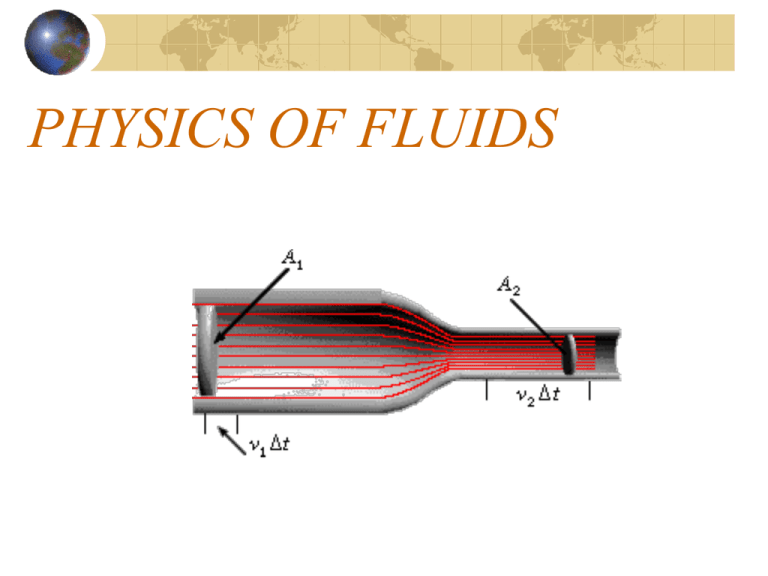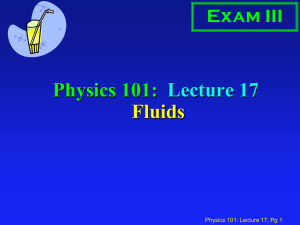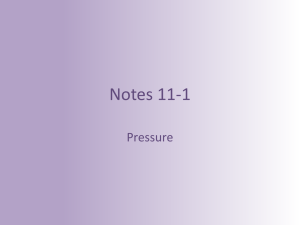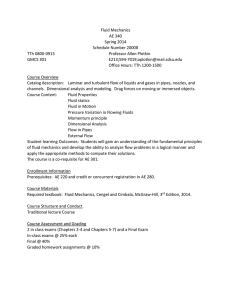Chapter 10 - TeacherWeb
advertisement

PHYSICS OF FLUIDS Fluids Includes liquids and gases Liquid has no fixed shape but nearly fixed volume Gas has neither fixed shape or volume Both can flow Density Mass per unit volume r = m/V (Greek letter “rho”) m = rV Example: Density of Mercury is 13.6 x 103 kg/m3 What is the mass of one liter? M = rV = 13.6 x 103 kg/m3 x 10-3 m3 = 13.6 kg Specific Gravity is ratio of its density to that of water (1.00 x 103 kg/m3 = 1.00 g/cm3) Density of water 1000 Kg per m3 1 Kg/liter 1 gram /cubic centimeter (cc) 1 cubic meter = 1000 liters 1 cubic centimeter = 1 milliliter 1 cubic meter = 1,000,000 cc Table of Densities Substance Density kg/m3 x103 aluminum Iron Lead Gold Water Sea water Alcohol, ethyl Mercury Ice 2.7 7.8 11.3 19.3 1.0 1.025 0.79 13.6 0.917 Pressure in Fluids Force per unit area Pressure = P = F/A Unit N/m2= Pascal(Pa) Exerted in all directions Force due to pressure is perpendicular to surface in a fluid at rest Pressure Varies with Depth as rgh Let depth be h. Assume incompressible. Force acting on area is mg = rVg = rAhg P = F/A = rgh Pressure at equal depths is the same If external pressure is also present it must be added DP = rg Dh h A Example: Pressure at Bottom of a Lake • What is the pressure at the bottom of a 20.0 meter deep lake? P = rgh = 1.0 x 103 kg/m3 x 9.8 m/s2 x 20m = 1.96 x 105 N/m2 due to the water What about the atmosphere pressing down on the lake? Atmospheric, Gauge and Absolute Pressure Average sea level pressure is 1 atm = 1.013 x 105 N/m2 (14.7 lbs/sq inch) Pressure gauges read pressure above atmospheric Absolute (total) pressure is gauge + atmospheric P = PA + PG What is total pressure at bottom of lake? Add 1.01 x 105 N/m3 to 1.96 x 105 Example: Water in a Straw Finger holds water in straw How does pressure above water compare with atmospheric? (hint: atmospheric pushes up from below) Pressure less because it plus weight of water must balance atmospheric What is the tallest column of water that could be trapped like this? rgH = 101,300 Pa; H = 101,300/(9.8 N/kg x 1000 Kg/m3) =10.3 m Pascal’s Principle Probably not tested Pressure applied to a confined fluid increases pressure throughout by the same amount Pout = Pin Fout/Aout = Fin/Ain Fout/Fin = Aout/Ain Multiplies force by ratio of areas Principle of hydraulic jack and lift Diagram courtesy Caduceus MCAT Review Pascal’s Principle in Action Measuring Pressure Open tube manometer simulation The pressure difference is rgh The (greater) pressure P2 = P1 + rgh How would this look if P1 was greater than P2 ? Diagram courtesy Sensorsmag.com Buoyancy Submerged or partly submerged object experiences an upward force called buoyancy Pressure in fluid increases with depth Studied by Archimedes over 2000 years ago. Buoyant Force on Cylinder h = h 2 – h1 FB = F2 – F1 = P2A – P1A = rFgA(h2 – h1) = rFgAh = rFgV = mFg h1 F1 A h2 h Buoyant Force equals weight of fluid displaced F2 Archimedes Principle Buoyant force on a body immersed (or partly immersed) in fluid equals weight of fluid displaced. Argument in general: consider immersed body in equilibrium of any shape with same density as fluid. FB up must equal weight down. Replacing body by one with different density does not alter configuration of fluid so conclusion would not change. Weighing Submerged object Sfy = 0 T +B - W = 0 T=W–B T = W – rFVg T is apparent weight W’ Diagram courtesy Caduceus MCAT Review Example: King’s Crown Given crown mass 14.7 kg but weighed under water only 13.4 kg. Is it gold? W’ = W – FB W = rogV W - W’ = FB = rF gV W/(W-W’) = rogV / rF gV = ro / rF ro / rH2O = W/(W-W’) = 14.7/(14.7 – 13.4) = 14.7/1.3 = 11.3 LEAD Another way to solve: isolate ro = W/gV and then get V from FB /rfg Floating Objects Objects float if density less than that of fluid. FB = W at equilibrium rFVdisp g = ro Vo g Vdisp / Vo = ro /rF Example: If an object’s density is 80% of the density of the surrounding fluid, 80% of it will be submerged Vo Vdisp Example: Floating Log 15 % of a log floats above the surface of the ocean. What is the density of the wood? Vdisp / Vo = ro /rF ro = Vdisp / Vo x rF = 0.85 x 1.025 x 103 kg/m3 = 0.87125 = 0.87 x 103 kg/m3 Example: Lifted by Balloon What volume of helium is needed to lift a 60 Kg student? FB = (mHe + 60 kg)g rair Vg = (rHe V + 60 kg) g V = 60 kg/(rair – rHe) = 60 kg/(1.29 – 0.18kg/m3) = 54 m3 Fluid Flow Equation of Continuity Volume rate of flow is constant for incompressible fluids (not turbulent) A1v1 = A2 v2 v is velocity Laminar vs. Turbulent Flow Erratic, contains eddies Fluid follows smooth path Courtesy MIT Media Laboratory Example: Narrows in a River A river narrows from 1000m wide to 100m wide with the depth staying constant. The river flows at 1.0 m/s when wide. How fast must it flow when narrow? 10 m/s Example: Heating Duct What must be the cross sectional area of a heating duct carrying air at 3.0 m/s to change the air in a 300 m3 room every 15 minutes? A1v1 = A2v2 = A2l2/t = V2/t A1 = V2/ v1t = 300m3 /(3.0 m/s x 900s) = 0.11m2 A2 A1 l2 Bernoulli’s Equation Where velocity of fluid is high, pressure is low; where velocity is low, pressure is high Consequence of energy conservation P + ½ rv2 + rgy = constant for all points in the flow of a fluid P + ½ rv2 = constant if all on same level Question If A1 is six times A2 how will the pressure in the narrow section compare with than in the wide section? Hint: P + ½ rv2 = constant Speed of Water Flowing Through Hole in Bucket P1 = P2 + ½ rv2 + rgz P1 = P2 since both open to air ½ rv22 + rgz = 0 v2 = (2gz)1/2 Torricelli’s Theorem Speed and Pressure In Hot Water Heating System If water pumped at 0.50 m/s through 4.0 cm diameter pipe in basement under 3.0 atm pressure, what will be flow speed and pressure in 2.6 cm diameter pipe 5.0m above? 1) find flow speed using continuity A1v1 = A2 v2 v2 = v1A1/A2 = v1pr12/pr22 =1.2 m/s 2) Use Bernoulli’s Eq. to find pressure P1 + ½ rv12 + rgy1 = P2 + ½ rv22 + rgy2 P2 = P1 +rg(y1 – y2) + 1/2r(v12 –v22) =(3.0 x 105 N/m2) + (1.0 x 103 kg/m3)x (9.8 m/s2)(-5.0m) + ½ (1.0 x 103 2 – (1.18m/s)2] = kg/m3)[(0.50 m/s) 5 2 = 2.5 x 10 N/m No Change in Height P1 + ½ rv12 = P2 + ½ rv22 Where speed is high, pressure is low Where speed is low, pressure is high Why Curveballs Curve Courtesy Boston University Physics Dept. web site How an Airfoil Provides Lift Where is the pressure greater, less? Courtesy The Aviation Group Crowding of streamlines indicates air speed is greater above wing than below Courtesy http://www.monmouth.com/~jsd/how/htm/airfoils.html Lift Illustrated Courtesy NASA and TRW, Inc. Sailing Against the Wind Sails are airfoils Low pressure between sails helps drive boat forward Courtesy Dave Culp Speed Sailing Venturi Tube Courtesy http://www.abdn.ac.uk/physics/streamb/fin13www/sld001.htm Bernoulli’s Principle also Helps explain why smoke rises up a chimney (air moving across top) Explains how air flows in underground burrows (speed of air flow across entrances is slightly different) Explains how perfume atomizer works Explains how carburetor works Giancoli Website



